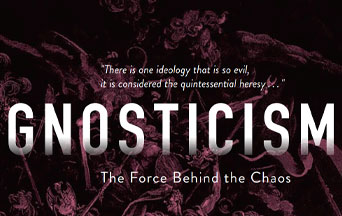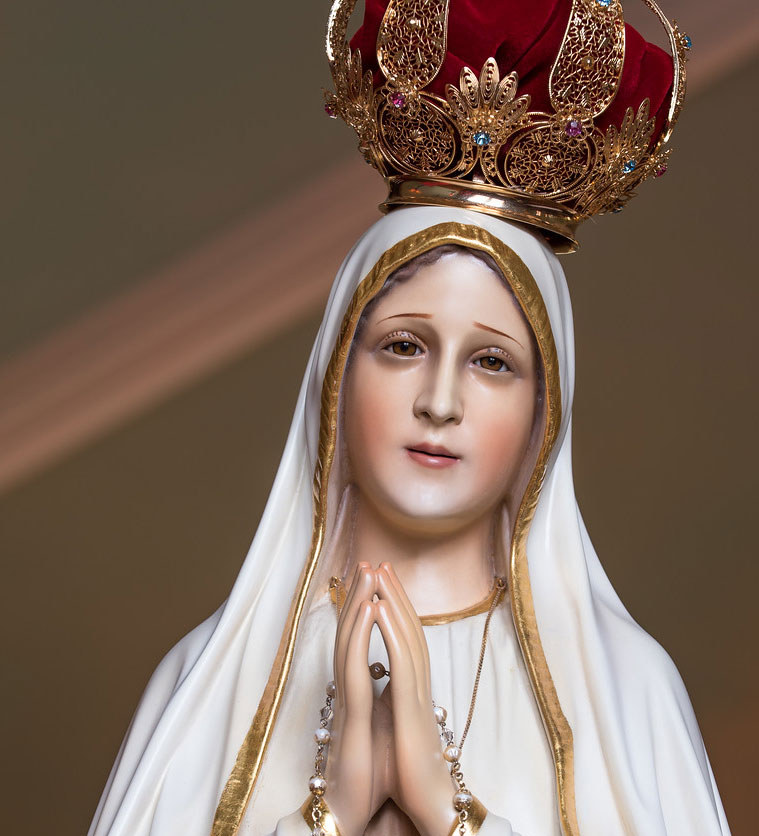
The life of a man, even the most dull and trivial, is metaphysics in action. This assertion by French sociologist Paul Bureau (1865—1923) is true. Because all ideas greatly influence the way we think and act. The motivational forces that drive our public and even private actions are deep down based on philosophies that we unknowingly follow.
The authors and promoters of consequential ideas are seldom known to us. We have probably never read nor studied their work. But as their ideas spread and filter into all branches of human knowledge, they are propagated in many ways and repeated thousands, nay millions of times, and eventually invade the arts, culture, religion, workplaces and practically all aspects of human life. In the end, they affect the way we think, act, live, work, rest and even die.
The Quintessential Heresy
Heretical ideas have caused people to suffer and die throughout history. However, there is one ideology that is so evil, it is considered the quintessential heresy—Gnosticism. The Church’s fight against it began in the second and third centuries A.D., but far from being ancient history, Gnostic beliefs are widespread even today. Although many people do not identify themselves as Gnostics, their approach to many issues and the way they arrange their lives is rooted in Gnostic thought. As a result, chaos ensues as revolutionary ideas almost always create disorder, tension and suffering amongst people. The multiple crises happening in our midst today can be profoundly traced to their Gnostic origin.
“There is one ideology that is so evil, it is considered the quintessential heresy…”

It is therefore especially important to understand Gnosticism and its derivative ideas to know what is going on in America today and in the world, and most importantly, why. It is also important to know the Christian response to it to stand firm in our beliefs. The Church Fathers, led by Saint Irenaeus of Lyon (130—202 AD), fought against ancient Gnosticism by preaching the true Gospel as opposed to the Gnostics’ false narrative which was set up to undermine Christianity. To attract adherents, the Gnostics claimed to have the answers to life’s key questions cleverly wrapped in Christian language. But Gnosticism is not only the concern of the Church. It is prevalent in secular society as well, thus making it critical for us to be aware of its implications in our daily lives and in our society at large.
Catholic thinker and author Professor Plinio Corrêa de Oliveira (1908—1995) explained that Gnosticism is so anti-Christian that it could only come from the mind of Satan himself. He wrote that “The Gnostic heresy is a doctrine radically opposed to the laws that God placed in the universe, because they represent His likeness. It aims, therefore, to make the universe the opposite of God’s likeness as much as possible. Ultimately, it aims at the destruction of being itself.”1
What Do Gnostics Believe?
To simplify a complex, illogical, sometimes contradictory idea such as Gnosticism is a challenge for most of us. Fortunately, several learned scholars and keen observers and thinkers have analyzed it well and exposed its many manifestations and ruses.
 Learn All About the Prophecies of Our Lady of Good Success About Our Times
Learn All About the Prophecies of Our Lady of Good Success About Our Times
Below is a gist of what Gnostics believe:
- The material world is bad, the spirit world is good. The material world is under the control of evil, ignorance or nothingness.
- A divine spark is somehow trapped in some (but not all) humans and it alone, of all that exists in this material world, is capable of redemption.
- Salvation is through a secret knowledge by which individuals come to know themselves, their origin and destiny.
- Since a good God could not have created an evil world, it must have been created by an inferior, ignorant or evil god.
From these core ideas, many more evil ideas were derived and have wreaked havoc throughout human history. Their authors and promoters may be known to intellectually curious minds, but the unlearned man on the street is ignorant of their identities, even less so of the evil ramifications of their ideas. In fact, those who are heavily influenced by Gnostic ideas may not even know of or believe in Gnosticism.
Since Gnostics believe that all matter is bad, they consider human bodies bad as well. Just this idea alone goes a long way in explaining extremes of immorality prevailing in society today.
How Do Gnostic Ideas Influence Morality?
First and foremost, since Gnostics believe that all matter is bad, they consider human bodies bad as well. Just this idea alone goes a long way in explaining extremes of immorality prevailing in society today. The implication is that there is no problem in indulging in sensual desires, since the body is totally corrupt. Therefore, the practice of reckless hedonism is justified, seeing no point in keeping the body pure. At the same time, the practice of severe asceticism is also justified, to keep our “evil” bodies in check.
Learn All About The Encyclical that Condemned the Sexual Revolution
In the area of sexual morality, the Gnostic view of the human body affects certain aspects of sexuality, gender identification, sexual orientation, sexual relations, marriage and procreation. For example, Gnostics believe that the distinction between men and women should be rejected because it is part of the “useless” creation order. The ideal is androgyny (a synthesis of male and female, and so neither one nor the other).2 On gender, since the “real you” is what you feel inside, the inner person overrides all external factors—including objective biological reality. Thus, the transgender movement claims that “gender identity” does not necessarily align with birth sex. A person can look within to decide whether he is a male or female or some other option, regardless of his body.

Many—if not all—of contemporary “slogans” have their roots in Gnostic thought.
If a living human body is insignificant and only the inner person is valuable, human worth would then depend on something “within,” such as self-awareness or knowledge. Consequently, an unborn child is often regarded as not yet a person and someone with advanced dementia may be viewed as no longer a person. Thus, Gnostics do not have a problem with abortion nor with euthanasia.
In marriage, Gnostics define it by feelings. The complementary natures of men and women do not matter. Marriage becomes a disembodied and subjective relationship between two or even more people. This means that marriage is adaptable, with same-sex “marriage” being just one consequence. Furthermore, concubinage and prostitution are preferable to marriage, since these are not permanent and not generally productive.3
10 Razones Por las Cuales el “Matrimonio” Homosexual es Dañino y tiene que Ser Desaprobado
The Gnostics abhor the conception of children. They regard a pregnant woman as having a devil in her, and they believe that procreation indefinitely replenishes the world and prolongs the captivity of the light, generation after generation.4 Misogyny (hatred of women) is advocated by Gnostics because women are potential mothers. Masturbation, homosexuality, sodomy and pedophilia are all preferable because these forms of sexuality do not result in the “hateful imprisonment” of more souls.
The bottom line is that Gnosticism is not concerned with a moral life, but with “mystical enlightenment” and freedom from the bondage of creation.5
Implications of Gnostic Ideas in Religion
Now we can imagine why Gnostics reject the idea of Our Lord Jesus Christ as a true man with a fleshly body. This heretical idea called Docetism, taught that Jesus Christ only ‘appeared’ to have a man’s body. So, Gnostics deny Our Lord’s true humanity, His Crucifixion and Death on the Cross and Resurrection from the dead. They claim that the Resurrection was not a physical but only a spiritual event.
Gnostics believe that our basic need is to escape into the perfect, non-physical ‘essence.’6 Salvation is therefore attained by enlightenment or knowledge (gnosis), affirming the divine spark within. This gnosis equips the chosen few to return to the realm of light after death.
Devotion to the Immaculate Heart of Mary Is so Crucial for Our Days
The implication for religion is clear. If salvation comes from within, who needs the Church, the Sacraments and the priests? Perhaps this explains why today, millennials and even a growing number of the older generation identify themselves as religiously non-affiliated.7 Does the phrase, “I’m spiritual, but not religious” sound familiar?
Implications of Gnostic Ideas in Politics and the Economy
When the Blessed Virgin Mary appeared to the three shepherd children in Fatima, Portugal in 1917, she warned that if her requests were not heeded, “Russia . . . will spread its errors throughout the world, promoting wars and persecutions of the Church . . .” The Mother of God was referring to communism. This totalitarian sociopolitical and economic system of government started in Russia and subsequently spread throughout Europe, Asia and Central America. As it turned out, many millions were lost and many more were subjugated under these cruel communist regimes.
Where did the idea of communism come from? German philosophers Karl Marx (1818—1883) and Fredrich Engels (1820—1895), who were the brains behind this evil idea, were adherents of the Gnostic myth of Darwinism. Darwin’s theory of evolution is Gnostic because it implicitly denies the transcendent origin of being. Marx and Engels envisioned the evolutionary development of society into a utopic dreamland by means of a perpetual class struggle among the social classes. With Marx’s principle called “dialectic materialism,” they hoped to eventually attain their “heaven on earth,” where there is no state, no classes (absolute equality), no religion, no private property, no freedom.8 In other words, a system of errors, as Our Lady of Fatima warned the world in 1917.
Furthermore, according to an insightful study by German-American political philosopher Eric Voegelin (1901—1985), other mass movements in modern times have their origins in Gnosticism. Voegelin found that all intellectual and political movements that aim to correct the world’s failings are Gnostic. The self-glorifying modern Gnostic redeemers exploit the passions of the people and resort to violence in the transformation of the wretched world into a utopian dream.9 Voegelin included progressivism, scientism, positivism, socialism, communism, fascism and psychoanalysis, as Gnostic in his exhaustive analysis of the modern age.
10 Reasons to Reject Socialism
Voegelin described the Gnostic mindset with these six characteristics:
- The Gnostic is dissatisfied with his situation,
- The belief that the world is poorly organized (as opposed to believing that the world is good but that human beings are inadequate),
- The belief that salvation from the evil of the world is possible,
- The belief that therefore the order of being will have to be changed (as opposed to the Christian belief that the world will remain as is and salvation is in grace through death),
- The belief that changing the order of being is within human ability,
- The belief that the task is to seek out the method of altering reality.10
Gnostic Ideas Found in Popular Culture
In addition to immorality, Gnostic ideas can be seen applied in various ways and degrees in today’s culture. Tattooing, body piercing, cosmetic surgery, body modification, sex change, are all ways of mistreating or abusing the body. Cremation is another way of denying the significance of the human body. Before the Church allowed cremation for practical reasons, the Christian custom of burying the dead, with the head facing east where the sun rises, demonstrates the hope of the resurrection of the body.

Gnostic ideas also play a key role in many films, novels, video games and the like, that promote finding who you really are and just “being yourself” as the path to true fulfillment. Themes of self-discovery, self-awareness, self-actualization and self-salvation, not to mention a dislike of any kind of authority, especially religious, are common in so many works of art, especially in the film industry.
Recognizing that Gnosticism still exists and that it is the force behind the chaos in our society, is the first step in combating this perennial heresy.
Another idea that is popular in today’s culture is environmentalism. Forty percent of Americans identify themselves as environmentalists.11 But amongst the forty percent, there are radical elements that believe the Gnostic and pantheistic idea that the Earth’s biosphere is God. They also believe that human beings are the destructive parasites, eating away at the life of their god. These radicals believe that they are the elect, the knowing, superior beings, apart from the rest of mankind.
Destruction of the Family
As we have seen, Gnostic ideas clearly target the traditional family. An institution founded by God Himself to form and regenerate society, the traditional family is rooted in an indissoluble marriage between a man and a woman. The Gnostic beliefs of non-traditional marriage, contraception, abortion and the rest of the deviant sexual behaviors and practices seek to destroy the traditional family, thereby thwarting God’s sacred plan.
Satan’s Ultimate Goal
Professor Corrêa de Oliveira wrote that the devil’s focus is to cause as many men as possible to go to Hell, to cause man to not perceive the good things God placed on earth so he will not be edified and sanctified. He wants to eliminate the beauty of material creation. The way to do this is destroy elements of variety and inequality that God placed in the universe, which reflect His likeness. Thus, the devil strives to present the most egalitarian culture possible. By eliminating all this and establishing uniformity and egalitarianism, the likeness of God is erased. This radical egalitarianism leads to pantheism, Gnostic belief that God and the universe are identical, that all are divine.
Equality and Inequality Among Men
But the devil’s goal is not only to present man with an egalitarian vision of the universe, but also a vision that destroys the very concept of being. He wants to implement a state of nothingness, to reabsorb creation into the primitive nothingness, which is gnosis. If he succeeds, he will have attained his ultimate goal.12
Christian Principles, the Antidote to Chaos
When the world rejects the metaphysical order of the created universe, chaos is inevitable. According to Professor Corrêa de Oliveira, chaos is the logical outcome of an anti-Christian society: “If there is a common denominator unfolding today in the private and public life of many nations, one can say that it is chaos. Chaotic prospects seem to repeat themselves and we increasingly tread the paths of chaos, no one knows how far.”13 Catholic author and educator Edward Leen, C.S.Sp. (1885—1944) postulates that “If Christianity in its integrity was accepted by all and its principles were applied in efforts to solve the practical problems of life, peace and comparative happiness would be the result.”14
To have a firm idea of the Gnostic heresy and its influence, gives us the opportunity to reaffirm our Christian beliefs and be sensitive to the heretical threats we face in our daily lives. In answer to the Gnostics, we affirm the following truths:
• We firmly believe that there is only one God, and He is the Creator of all things. We reject the idea of an evil world. The source of evil in this world is man’s sinful rebellion against God, not the physical world itself.
• We reject the Gnostic idea of an evil body since our bodies are intrinsic to us and are designed in wisdom and love by our good Creator, to serve and glorify Him. Our bodies are temples of the Holy Ghost, and we honor God with our bodies by living in obedience to Him. Far from an empty shell, our bodies will be raised again to a new life forever.
• Human life is uniquely precious as created in God’s image. Our significance derives from this, not from our “quality of life,” age or capability.
• God grounds marriage in His creation. It is defined as being between a man and a woman and forms the foundation for family and society. Marriage is the framework within which love can thrive and children can be raised. God also gives human marriage as a picture of the ultimate marriage between Christ and His Church.
• Our Lord Jesus Christ is fully God and man. He is the eternal God—the Word Who was in the beginning, Who was with God (John 1:1). Scripture reveals that He became fully man. The Incarnation is at the heart of our faith, making redemption possible.
• Every human being needs redemption from sin. But our loving and wise Creator gave His Son to save lost sinners. Salvation comes through faith in Him, not from looking within ourselves.
Fighting Gnosticism
The more we fight against Gnosticism the more we will be grounded in our Christian beliefs. As sociologist Lester Kurtz wrote, “What people do not believe is often more clearly defined than what they do believe, and it is through battles with heresies and heretics that orthodoxy is most sharply delineated.”15
Finding the Real Soul of the Apostolate
Recognizing that Gnosticism still exists and that it is the force behind the chaos in our society is the first step in combating this perennial heresy.
There are various ways to fight Gnosticism. Dr. Ben Reinhard of Christendom College suggests that there are two factors behind why Gnosticism’s influence is widespread today: loss of trust in public officials and the Internet. He writes, “It is easy to believe the world is evil when so many of its leaders manifestly are. Even more dramatically, however, the crisis of public confidence makes the allure of gnosis especially hard to resist.”16 The second major factor according to Dr. Reinhard, is the all-encompassing embrace of the Internet. He considers the Internet the Gnostic invention par excellence. It provides access to a dream world of unfettered spirit, overwhelming us with limitless information far disproportionate to man’s capacity to know, designed to be addictive by algorithms that take their users ever deeper into this virtual world. And, with the smartphone, nearly everyone today carries his own personal portal into this disembodied world.
According to Reinhard, to fight Gnosticism we must learn to foster wisdom instead of mere knowledge, and to turn as best we can from the pseudo-world of social media, propaganda and relentless news towards reality: life with our families, reading of Scriptures and the writings of the saints and especially liturgical prayer and the Sacraments.

The Destroyer of All Heresies
The Blessed Virgin Mary is the Patroness of all those who fight against the Revolution. And because of her absolute fiat to God, she is also the destroyer of all heresies. At Fatima, she outlined a “survival guide” which she guarantees will save us. It requires prayers, penance, amendment of life and devotion to her Immaculate Heart. If we follow her advice, she promised that we will be saved. And that finally, her Immaculate Heart will triumph and there will be peace in the world. This intervention of the Mother of God and our loving mother, is the counter-revolutionaries’ greatest reason for hope.
Footnotes
- Plinio Corrêa de Oliveira, Egalitarianism: The Metaphysical Value and Religion of Our Days, (Tradition, Family, Property Association, 2011), 47.
- Benjamin Walker, Gnosticism, Its History and Influence (Aquarian Press, 1983), 121.
- Ibid., 126.
- Ibid., 120.
- Ibid., 100.
- Ibid., 56-57.
- Michael Lipka, “A closer look at America’s rapidly growing religious ‘nones,’” (Pew Research Center, May 13, 2015).
- Luiz Sérgio Solimeo, Exposing Socialism: The “Errors of Russia,” (America Needs Fatima).
- Eric Voegelin, Science, Politics & Gnosticism, (Henry Regnery Company, 2004), 61.
- Ibid., 64.
- Jeffrey Jones, “Four in 10 Americans Say They Are Environmentalists,” (Gallup).
- Plinio Corrêa de Oliveira, Egalitarianism: The Metaphysical Value and Religion of Our Days.
- Roberto de Mattei, Plinio Corrêa de Oliveira, Prophet of the Reign of Mary, (Preserving Christian Publications, 2019), 59.
- Edward Leen, C.S.Sp., Why the Cross?, (Scepter Publishers, Inc., 2001), 9.
- Lester R. Kurtz, The Politics of Heresy, (University of California Press, 1986), 1.
- Ben Reinhard, “The Attractions and Failings of the Modern Gnosticisms,” The Catholic World Report, March 7, 2021.
